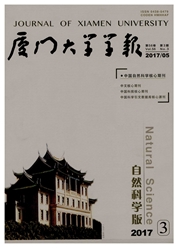

 中文摘要:
中文摘要:
蓝藻Synechococcus sp.PCC7942 HCO3^-高亲和转运蛋白操纵子基因cmpABCD是其CO2浓缩机制中的调控基因之一.本研究用携带潮霉素B磷酸转移酶基因(hygromycin B pho transferase,hpt)筛选标记的同源双臂整合载体pUC-HATH转化蓝藻Synechococcus sp.PCC7942,以潮霉素B作为筛选试剂筛选出具潮霉素B抗性的转化藻,运用引物PCR方法证实潮霉素B磷酸转移酶基因表达盒通过质粒pUC-HATH的介导已定点插入蓝藻Synechococcus sp.PCC7942基因组中,成功地构建了具有潮霉素B抗性的cmpBCD基因插入失活突变藻株,并最终通过比较野生藻Synechococcus sp.PCC7942和突变藻Synechococcus sp.PCC7942在不同Na2CO3浓度的改良BG-11培养基中生长特性,探讨了HCO3^-高亲和转运蛋白操纵子cmpABCD基因失活对藻体生长的影响.
 英文摘要:
英文摘要:
The cmpABCD genes of Synechococcus sp. PCC 7942 which encoded an ABC-type HCO3^- transporter involved in inorganic carbon (Ci) transporting in cyanobacterial CO2 concentrating mechanism (CCM), was amplified by PCR. And the resulting cmpBCD fragment was cloned in plasmid pUC19 to generate plasrnid pUC-HATH. By inserting an hygromycin B pho transferase (hpt) cassette into the coding region of operon gene cmpABCD + 1 508~+ 1 509 district in pUC-HAT, the homogenetic integration plasmid vector pUC-HATH was constructed and used to transform the Synechococcus sp. PCC 79402 wild-type strain, and a mutant with resistance to hygromytin B was obtained. PCR analysis of the genomic DNA from the resulting mutant indicated that the appropriate deletion and insertion indeed had occurred. The cell growth of the mutant didn't show quite different from those of the wild-type strain in improved BG-11 culture medium, which suggested that inactivation of cmpABCD genes in Synechococcus. sp. PCC7942 had little effect on the HCO3^- transport activity.
 同期刊论文项目
同期刊论文项目
 同项目期刊论文
同项目期刊论文
 期刊信息
期刊信息
